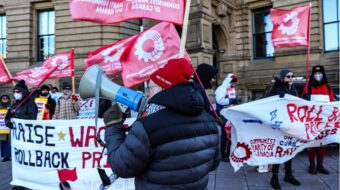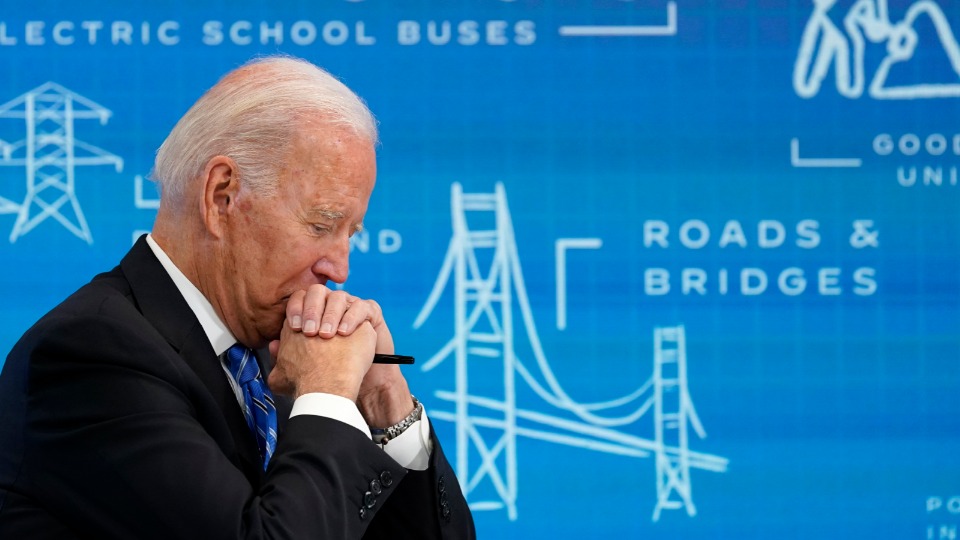
WASHINGTON—For workers and for people who know their political and U.S. history, at least when it comes to conditions that give rise to sharp increases in the numbers of progressive lawmakers winning elections, the results on Election Day 2020 were expected to be much better than they were. Why did the 2020 results not yield the kind of sweeps by progressives that were seen amidst the Great Depression in the 1932 election? In 2020, we did see GOP losses but in the House, it was an extremely narrow defeat, and we have a Senate evenly divided, with Biden having to fight like hell to enact his progressive agenda.
By November 1932, the nation had been mired in the Great Depression for three years. Official unemployment rates peaked above 25%. Millions of people had been evicted. Former office workers sold apples on the streets, at a nickel apiece. People scrounged for scraps of leftover food in garbage heaps.
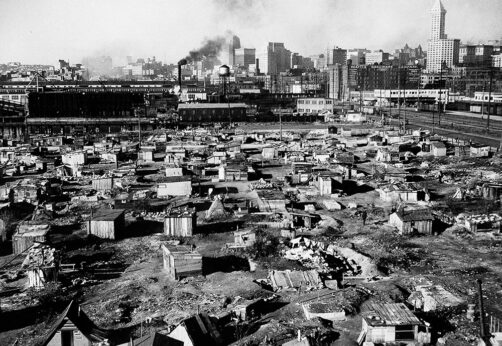
“Hoovervilles,” cities of shanties housing families who had lost their savings, jobs, and homes in the crash, dotted the nation, and conditions were bad even before that. A University of Wisconsin historical study more than a decade ago put the pre-1929 pre-Depression poverty rate at just above 50%. But the researchers cautioned the data is scanty.
Banks failed. Sheriffs foreclosed on farms. Thousands of jobless men became hobos, riding the rails. Throw the Dust Bowl in atop all that.
And the federal government, under Republican President Herbert Hoover, was ineffectual at best and pro-corporate or worse the rest of the time. His prescription was to wait for “economic adjustment.” Balanced budgets were Hoover’s mantra; helping suffering people was not. He even sent police and Gen. Douglas MacArthur’s troops to drive out a peaceful “Bonus Army” of World War I veterans from a Washington, D.C., encampment. Two vets died from police gunfire.
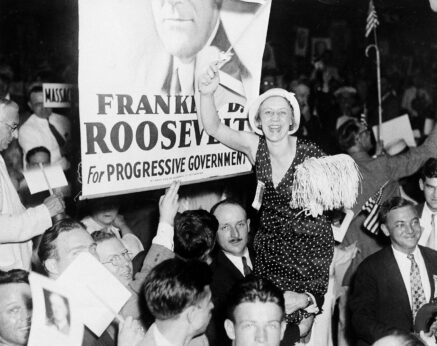
That horrified the nation, too. The net result of it all: An historic Democratic landslide in November 1932.
New York Gov. Franklin D. Roosevelt beat Hoover by 7,066,619 votes, winning 57.4% to Hoover’s 39.6%. The electoral vote was 472-59. Only three small states were close. The House Democratic margin went from 220-214 in the 1930 election—a year after the crash began—to 310-117 in 1932 (not counting vacancies). The Senate switched from 48-47 Republican to 60-35 Democratic, plus Progressive Robert LaFollette of Wisconsin.
The election that should have been
Now, look at the nation’s situation last November, and the election results.
A raging pandemic ravaged the country, as hundreds of thousands of businesses closed to combat the coronavirus’s community spread. By Election Day, that modern-day plague had killed 235,000 people, and millions had tested positive. Joblessness neared 20% in official numbers and went beyond that once you added up all the relief check recipients.
Republican Oval Office occupant Donald Trump’s response was public denial, lies, misinformation, and quack cures, such as recommending people drink bleach to kill the virus ravaging their lungs. He pushed schools to reopen unsafely and prematurely and forced “essential” workers, especially in meatpacking and medical care, to toil on the job and expose themselves to danger even when bosses refused to protect them.
And prior to that, Trump ran the most lopsidedly pro-corporate regime since Hoover and his GOP predecessor, Calvin Coolidge. Racist and xenophobic Trump was dictatorial, too.
Workers were mistreated and exploited. Worker rights were denied or trashed. What worker protections the Trump Labor Department couldn’t yank, the Trump-named National Labor Relations Board majority tried to kill. And if that didn’t work the Supreme Court stepped in to trash worker rights. Trump’s NLRB General Counsel even schemed to outlaw Scabby The Rat. (That case slid into this year, and it failed.)
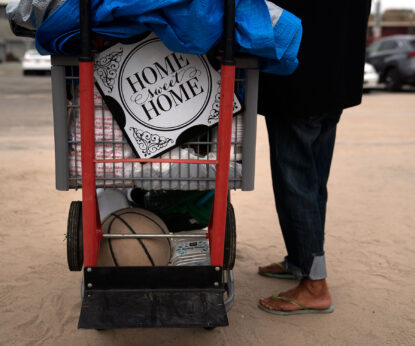
And the 2017 Trump-GOP tax cut for corporations and the rich was so lopsided that an executive making millions of dollars a year got a cut so large he could buy a new set of high-end tires for his SUV every day. A minimum-wage worker got a daily tax cut, too: 11 cents.
History and ensuing angst forecast a rerun of 1932 this past November but it didn’t occur.
Biden won, but that was about it. In a record turnout, he beat Trump by 7,052,696 votes, 51%-47%. The electoral count was 306-232. Biden’s popular vote margins were small in key swing states, notably Arizona (10,457), Georgia (11,579), and Wisconsin (20,608). The biggest, Pennsylvania, swung to Biden by 80,555 in the wee morning hours after Nov. 3.
Democrats gained four Senate seats. But two came after Dems and allies spent tens of millions of dollars and after progressives and unionists—led by Unite Here—flooded Georgia to campaign for them in a Jan. 5 runoff. Those Georgia wins produced only a 50-50 Senate tie.
Democrats lost 12 House seats, dropping to a 222-212 edge with one vacancy. They lost again in state legislatures, setting themselves and workers up for carnage in coming years due to GOP gerrymandering. Mitch McConnell, R-Ky., is still Senate GOP leader, not retired.
In short, the pro-worker Democratic-labor landslide that should have occurred didn’t. Why?
Election autopsy 2020
As might be expected, some in the two wings of the Democratic Party blame each other.
Some moderates from swing districts say the result occurred because the GOP was able to hang the “socialist” label on Democrats, linking them all to the progressive “Squad” of four Democratic congresswomen of color elected in 2018. The moderates also charge the GOP successfully painted all Dems as wanting to “defund the police” in the wake of nationwide racial justice protests following a Minneapolis cop’s murder of George Floyd.
The progressives shot back that moderation doesn’t win you elections. A party needs to stand for something—something besides ousting Donald Trump, who was an existential danger to democracy on top of his policies. On that goal and cause, both wings agreed.
But the real answer appears to be more complex. Again, let’s go back to 1932 as a comparison. Here are some outstanding contrasts:
- In 1932, the “Solid South” was solid for FDR, and all the votes were white. The white nationalist wing of the party ruled. Black Americans who hadn’t migrated yet to cities like Chicago, Detroit, Cleveland, and L.A.—to escape repression or find jobs—couldn’t vote. The Ku Klux Klan, often with a noose, pursued those who tried.
- In 2020, all over the nation, Black Americans were able to vote and did so by the millions last November—a result GOP-dominated governments inside and outside the South are now busily erasing through voter repression laws.
- There’s still a Solid South in 2020, but it’s mostly solid Republican. The overwhelming Black vote for Biden produced a few cracks. Biden carried Virginia handily and Georgia narrowly. He lost North Carolina by just over 74,000 votes, compared to Hillary Clinton’s 173,000-vote loss to Trump four years before.
- The country had and has a huge racist streak. In 1932, it was public. But even with Klan members marching not just in Alabama and Mississippi but in Oregon and Indiana, there was a stigma attached. Thanks to Trump, the white nationalist descendants of the Klan, whom he called “good people,” came out of the political woodwork. They cast Republican ballots while attempting to intimidate Black voters and people of color.
- The mass media landscape has turned upside down, to the advantage of corporate interests, outright liars like Trump, and right-wing conspiracy theorists.
- In 1932, radio was the biggest broadcast medium, but it still took a back seat to newspapers. Many of them were slanted, with the Hearst chain and the Chicago Tribune leading the way. Three networks, the Mutual Broadcasting System, CBS, and NBC, dominated radio. They played it relatively straight. TV did not exist. Right-wing demagogues, such as Sen. Huey Long, D-La., and Father Charles Coughlin, were on the air, too. But their reach was regional (Long), confined to one religion (Coughlin), or drowned by the Depression.
- By 2020, most newspapers that survived had lost their clout, their readers, their revenue, and much of their staff. The internet overwhelms the media landscape. Unregulated and uncontrolled, it’s run by a few big nationwide content providers and social media behemoths who have all the ad money newspapers used to reap, and more—and who don’t employ editors to sift out facts from falsehoods.
Trump realized it, spending $268.6 million on social media, Open Secrets reported. So did Biden: $199.8 million. But Biden had to spend a lot to overcome his primary foes, who combined to spend at least an additional $62 million. The GOP rigged its own rules to foreclose opponents.
- Meanwhile, corporate interests have for years funded and constructed a big lie media machine, powered by right-wing think tanks, conspiracy theorists, and millions of followers who can reach the machine with a mouse click. Those millions are not exposed to competing ideas, ignore them, or both. Clicks reap ad dollars.
- There were strong political party machines in 1932 that could deliver Democratic votes, in Connecticut, New York City, Chicago, Philadelphia, Baltimore, Boston, Jersey City, Kansas City, Mo., and elsewhere. Now, the few existing party machines now reach only locally.
- Social media and openly political pro-GOP right-wing evangelical churches, notably megachurches led by white nationalist male preachers, are the 21st century’s political machines. They swing voter blocs. The two national parties are organizations in name only. The Republicans can’t control the white nationalists. The Democrats have to rely on labor and allied groups to provide the precinct foot soldiers they need.
Republicans know how to fight today’s war
Over the years since 1932, and especially since 1960, the Republicans have adjusted to, taken advantage of, and created this new landscape. They intentionally converted politics to a take-no-prisoners war, winnable by any means, foul or fair. They brand political foes as traitors. They target people of color, throwing up apocalyptic visions of a multi-racial, multi-cultural national future, designed to scare white people into following racists and voting Republican.
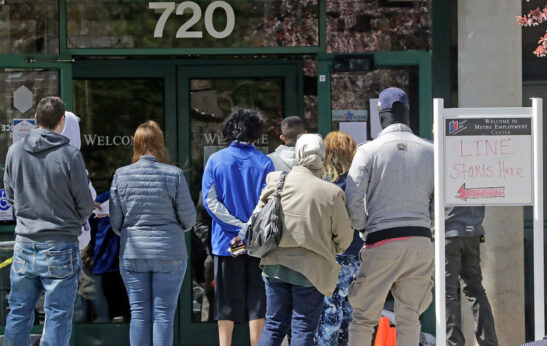
Workers and their Democratic allies, and a few remaining “traditional” Republicans, are still playing by the old rules. For them, politics is policy and vice versa. It’s practical and definitely not deadly. Those practical practitioners include Biden.
When the radical and racist right got too powerful and concentrated control in one pseudo-dictator—Trump—a majority of the country rose up against him. Biden was their vehicle. But “rising up” didn’t include ousting Trump’s enablers, right-wingers and racists down the ballot, or overcoming their lies. Unions tried but succeeded only partially. If they had, McConnell would be cooling his heels in Louisville and Amy McGrath or Charles Booker would be a senator.
This, we can conclude, is why Biden won, and many of the other worker-backed hopefuls, who should have benefited from a 1932-like landslide, didn’t.
We also conclude, however, that the battle is not a hopeless one. Despite the right-wing gains that made this election so different than 1932, we did see victories, and we are on the cusp of perhaps winning some really historic additional ones. The people ousted Trump from the White House, kept the racist Republicans from gaining control of the House, and with the election of Kamala Harris as vice president won the ability to break ties in the Senate, a power they did not have during the Trump years.
The people are also benefitting from a multi-trillion dollar American Rescue Plan that has lifted millions out of poverty with monthly checks for each of their children. And we are on the verge of possibly winning passage of the most sweeping progressive legislation on hard and human infrastructure since the New Deal of the 1930s.
Those victories happened because of the coming together of a huge and broad coalition of labor and all of its allies. If we can keep that coalition together and make it bigger and broader than ever, we will have found the weapon that can win against the well-armed and dangerous right wing in this country. If we fail to keep it together, the results could be too horrible to contemplate.





